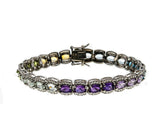Over The Rainbow - Estate Sterling Silver Multi Gemstone 'Citrine, Peridot, Prasiolite, Amethyst, Blue & White Topaz' Tennis Bracelet (EB026)
Rarities Antique Jewelry
Over The Rainbow - Estate Sterling Silver Multi Gemstone 'Citrine, Peridot, Prasiolite, Amethyst, Blue & White Topaz' Tennis Bracelet. This gorgeous bracelet is crafted from sterling silver, hallmarked 925, and a makers mark DL. Featuring 3 natural oval cut faceted citrine, 4 natural oval cut faceted peridot, 4 natural oval cut faceted prasiolite (green amethyst), 4 natural oval cut faceted purple amethysts, 3 natural oval cut faceted lilac amethysts, 4 natural oval cut faceted Swiss blue topaz, 3 natural oval cut faceted sky blue topaz, and one natural oval cut faceted white topaz gem. This bracelet is comprised of decorative links, which are expertly claw-set with beautiful natural gemstones displaying a wonderful variation of color. The bracelet has a hidden clasp, and two addition hooks for security. This estate bracelet is versatile and elegant, therefore it can be worn day or night, with anything and everything!
Comments: Stunning design, and beautiful color combination.
History: Citrine - In ancient times, people believed that citrine gemstones could calm tempers, soothe anger and manifest desires, especially prosperity. To leverage these powers, Egyptians used citrine gemstones as talismans, the ancient Greeks carved iconic images into them, and Roman priests fashioned them into rings.
Peridot - These ancient Egyptian gemstones came from deposits on a small volcanic island in the Red Sea called Topazios, now known as St. John's Island or Zabargad. Ancient Egyptians called peridot the “gem of the sun,” believing it protected its wearer from terrors of the night.
Prasiolite - Prasiolite was initially discovered in Poland during the early 19th century. Its name is derived from "prason" and "lithos," which are Greek terms that mean "leek" and "stone," respectively. Generally, prasiolite is pronounced how one would expect.
Amethyst- Ancient Greeks and Romans believed this gemstone could ward off the intoxicating powers of Bacchus and keep the wearer clear-headed and quick-witted. English regalia were decorated with amethysts during the Middle Ages to symbolize royalty. Amethyst jewelry has been found and dated as early as 2000 BC.
Blue Topaz - The origins of this gem were discovered and mined in 1960 by British explorer Max Ostro in Minas Gerais, Brazil. The UK Natural History Museum impressively has the largest cut topaz to ever go on display at their museum.
During the Renaissance in Europe, people believed that topaz could break spells and quell anger. Hindus deemed topaz sacred, believing that a pendant could bring wisdom and longevity to one's life. African shamans also treated the gemstone as sacred, using it in their healing rituals.
Slag heaps near ancient mine workings in Turkey and Greece prove that silver mining started around 3000 BC. The metal was refined by cupellation, a process invented by the Chaldeans, who lived in what is now southern Iraq.
The term "sterling silver" probably originated in eastern Germany when five towns formed the Hanseatic League in the 1100s. These town minted their own coins of 92.5 percent silver. When Britain sold cattle and grain to the League, they were paid in "Easterling coins".
Measurements: Bracelet 7"
Stone Size: Multi Stones (Citrine, Peridot, Prasiolite, Amethyst, Blue Topaz, and white Topaz 7.80 carats
Weight: 17.90 grams
Condition: Excellent
Origin: Asia
Date: Circa 1990























